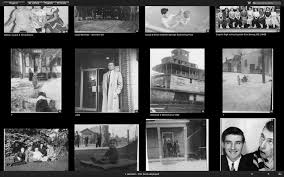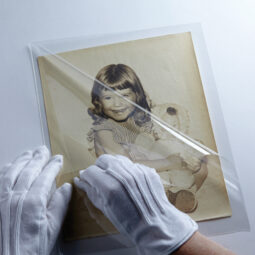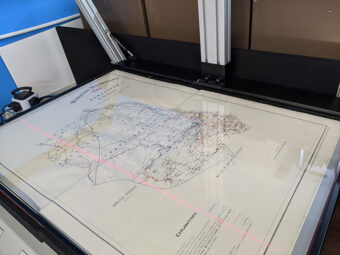
Medium Format Film – Safety Film Conversion at Oxford Duplication Cenm
Safety Film vs Nitrate Film: Working with our client World History Archive, they commissioned us to prepare over a course of several years their archives of safety film. Currently we are several thousand in to a 24,000 order!
A LITTLE HISTORY
The term “safety film” contrasts with the flammable nature of the earliest plastic-based roll films. The film in George Eastman’s first Kodak camera (1888) was paper-based, but that entailed transferring the gelatin emulsion to a glass base during development.
Luckily, Hannibal Goodwin had invented transparent flexible nitrocelluose plastic based roll film in 1887. Eastman promptly stole the idea and, the Kodak began using a 2 3/4 inch wide transparent flexible nitrocelluose plastic based roll film in 1889.
In 1891, this film was slit lengthwise to 1 3/8 inch (35 mm nominal) width to create nitrocelluose-based film for Thomas A. Edison and William K. L. Dickson’s Kinetograph/scope camera/viewer system and it became the standard medium of the emerging motion picture industry – hence the term “celluloid” as slang for movies. Note, Goodwin did not receive his patent until 1898 and Eastman would pay $5 million to Goodwin’s heirs and assignee after losing a protracted patent court fight in 1914.
Unfortunately, nitrocelluose is highly flammable and autocatalytically decomposes after fairly short-term storage into spontaneously combustible, and ultimately spontaneously explosive, powder; even when well cared for. (Nitrocelluose is the basis of modern smokeless gunpowder.) The use of nitrocelluose as a plastic declined in the 1920s and 30s as substitutes became available.
In 1908, Eastman invented “safety film” using a stable cellulose acetate plastic base. It was publicly revealed in 1909 and first used for 22 mm gauge movie film in 1910.
Acetate burns only if ignited, takes a long time to decompose and is definitely not explosive. However, it was not popular until 1923 when Eastman used acetate safety film exclusively for its new Cine-Kodak amateur 16 mm movie system. Safety film was not as strong as nitrate film and was not offered for professional 35 mm motion picture stock until 1948 when the modern triacetate form replaced the original diacetate and finally passed rigorous industry tests.
This long delay in changing over to acetate film resulted in the complete self-destruction of many pre-World War II movies and has been bemoaned by film historians for decades. For example, there are, apparently, no extant first generation copies of King Kong (1933) or Metropolis (1927).
In 1935, Eastman introduced 135 type cartridge film, the film used by virtually all 35 mm still cameras in the second half of the 20th century. It was acetate-based from the beginning. In other words, all 135 film is safety film. All 126 Kodapak Instamatic (1963) and 110 Pocket Instamatic (1972) film were also acetate-based safety films. I think all 828 roll film (1935) was safety film. This was trumpeted for decades by the “KODAK SAFETY FILM” tag pre-exposed onto the film edge. The tag seems to have been removed as superfluous sometime in the late 1980s/early 1990s.
All 35 mm motion picture film since 1952 is also safety film. This included the “4 digit” type Eastman Color Negative 5254 (introduced in 1968; ASA 100 tungsten [3200 K] balanced) or 5247 (1974; ASA 100 tungsten) and Color High Speed Negative 5293 (1982; ASA 250 tungsten) or 5294 (1983; ASA 400 tungsten) films reloaded into 135 cartridges by Seattle (WA) Film Works, Dale Labs (Hollywood, FL), Lab 47 (Hollywood, CA), etc., to offer mail-order prints and slides from the same film during the 1970s and 80s. Therefore, choosing between “safety film” versus “nitrate film,” is not today, nor has been for many decades, relevant for any photographer or cinematographer.
Note, modern film is not necessarily acetate-based. Some Kodak cine and still films from 1956 onward are Estar-based. Estar is a Kodak brand of archival quality polyethylene terephthalate (a polyester similar to DuPont’s Mylar). For example, large format sheet films post-circa 1970, the famed Technical Pan Film 2415 (1977) supersharp black and white 35mm film, and the Disc (1982) snapshot film format were Estar-based. Other film manufacturers have used their own Mylar-like plastic. Advanced Photo System (APS IX240) film (1996) was also a polyester safety film, although never called as such. It was polyethylene naphthalate-based.
More in Office Services

Catering laundry solutions for spotless table linens by Freya Gutteridge, Oxwash
In the catering industry, pristine table linens are essential for enhancing both presentation and hygiene. Crisp, spotless linens create a professional atmosphere and ensure a safe dining environment for guests. Effective laundry solutions, such as the use of biodegradable detergents and advanced washing techniques, help maintain fabric quality and remove tough stains without harming the environment.

Aston & James Wins Dealer of the Year at National Industry...
The BOSS Federation National Industry Awards Since 1905 BOSS has been the authoritative body for the UK business supplies industry, supporting the sector and its people. It is a not-for-profit organisation that concentrates its efforts on playing a strategic role in the support, promotion and protection of the industry. BOSS represents all businesses along the […]

100 Coats for Those Who Are Homeless in Oxfordshire This Winter
Help us donate 100 coats for those who are homeless in Oxfordshire this winter! Many of us enjoy the luxury of heat and shelter when the weather turns, but many people in Oxfordshire don’t have anywhere to call home. When the cold weather commences those in our community desperately need clean warm coats to help […]
From this author

Do You Have Paperbased Records – Its Time to Protect Those...
A very important reason to archive your documents and archives is to avoid losing data. All documents are vulnerable to being destroyed, deleted, natural disaster, such as a flood or fire. A more serious reason for document archiving is deterioration of the papertypes. I cannot count the number of times we have experienced paper […]

Maps, Plans & Posters | Oversized Scanning Solutions
Our services at Oxford Duplication Centre offer oversize scanning solutions for maps, plans and posters of any document type, from parchment, linen, cotton and paper. Our archive technicians have extensive experience in digitising complex document types into high quality digital files, ideal for archival purposes, viewing and uploading. Output formats are straightforward offering any type […]

Why You Should Consider Your Documents And Have Them Digitally Preserved.
Digitising paper documents into secure & accessible electronic records. Our services at Oxford Duplication Centre offer a complete range of document scanning solutions to digitise archives of existing records. We can handle any type of document, from student records to complex technical drawings, from a single file through to entire archives. Our services digitise upto […]

